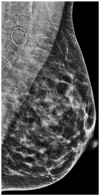Breast cancer screening in the era of density notification legislation: summary of 2014 Massachusetts experience and suggestion of an evidence-based management algorithm by multi-disciplinary expert panel
- PMID: 26290416
- PMCID: PMC4592317
- DOI: 10.1007/s10549-015-3534-9
Breast cancer screening in the era of density notification legislation: summary of 2014 Massachusetts experience and suggestion of an evidence-based management algorithm by multi-disciplinary expert panel
Abstract
Stemming from breast density notification legislation in Massachusetts effective 2015, we sought to develop a collaborative evidence-based approach to density notification that could be used by practitioners across the state. Our goal was to develop an evidence-based consensus management algorithm to help patients and health care providers follow best practices to implement a coordinated, evidence-based, cost-effective, sustainable practice and to standardize care in recommendations for supplemental screening. We formed the Massachusetts Breast Risk Education and Assessment Task Force (MA-BREAST) a multi-institutional, multi-disciplinary panel of expert radiologists, surgeons, primary care physicians, and oncologists to develop a collaborative approach to density notification legislation. Using evidence-based data from the Institute for Clinical and Economic Review, the Cochrane review, National Comprehensive Cancer Network guidelines, American Cancer Society recommendations, and American College of Radiology appropriateness criteria, the group collaboratively developed an evidence-based best-practices algorithm. The expert consensus algorithm uses breast density as one element in the risk stratification to determine the need for supplemental screening. Women with dense breasts and otherwise low risk (<15% lifetime risk), do not routinely require supplemental screening per the expert consensus. Women of high risk (>20% lifetime) should consider supplemental screening MRI in addition to routine mammography regardless of breast density. We report the development of the multi-disciplinary collaborative approach to density notification. We propose a risk stratification algorithm to assess personal level of risk to determine the need for supplemental screening for an individual woman.
Conflict of interest statement
Figures


References
-
- Are You Dense Advocacy, Inc. [Accessed January 2015];DENSE® State Efforts. Available at http://areyoudenseadvocacy.org/dense/
-
- Hooley RJ, Greenberg KL, Stackhouse RM, Geisel JL, Butler RS, Philpotts LE. Screening US in patients with mammographically dense breasts: initial experience with Connecticut Public Act 09-41. Radiology. 2012;265(1):59–69. - PubMed
-
- Tice JA, Ollendorf DA, Lee JM, Pearson SD. The Comparative Clinical Effectiveness and Value of Supplemental Screening Tests Following Negative Mammography in Women with Dense Breast Tissue. [Last accessed December 5, 2014];Institute for Clinical and Economic Review (ICER) 2013 Available at http://www.ctaf.org/sites/default/files/assessments/ctaf-final-report-de....
-
- California Technology Assessment Forum (CTAF) [Accessed December 5, 2014];Supplemental Cancer Screening for Women With Dense Breasts: Questions for Deliberation and Results. 2013 Sep 25; Available at http://www.ctaf.org/sites/default/files/u39/Voting%20question%20main_res....
-
- New England Comparative Effectiveness Public Advisory Council (CEPAC) [Accessed December 5, 2014];An action guide for supplemental cancer screening for women with dense breasts: next steps for patients, clinicians, and insurers. http://cepac.icer-review.org/wp-content/uploads/2013/11/Action-Guide-Den.... Date of publication March 2014.
Publication types
MeSH terms
Grants and funding
LinkOut - more resources
Full Text Sources
Other Literature Sources
Medical

